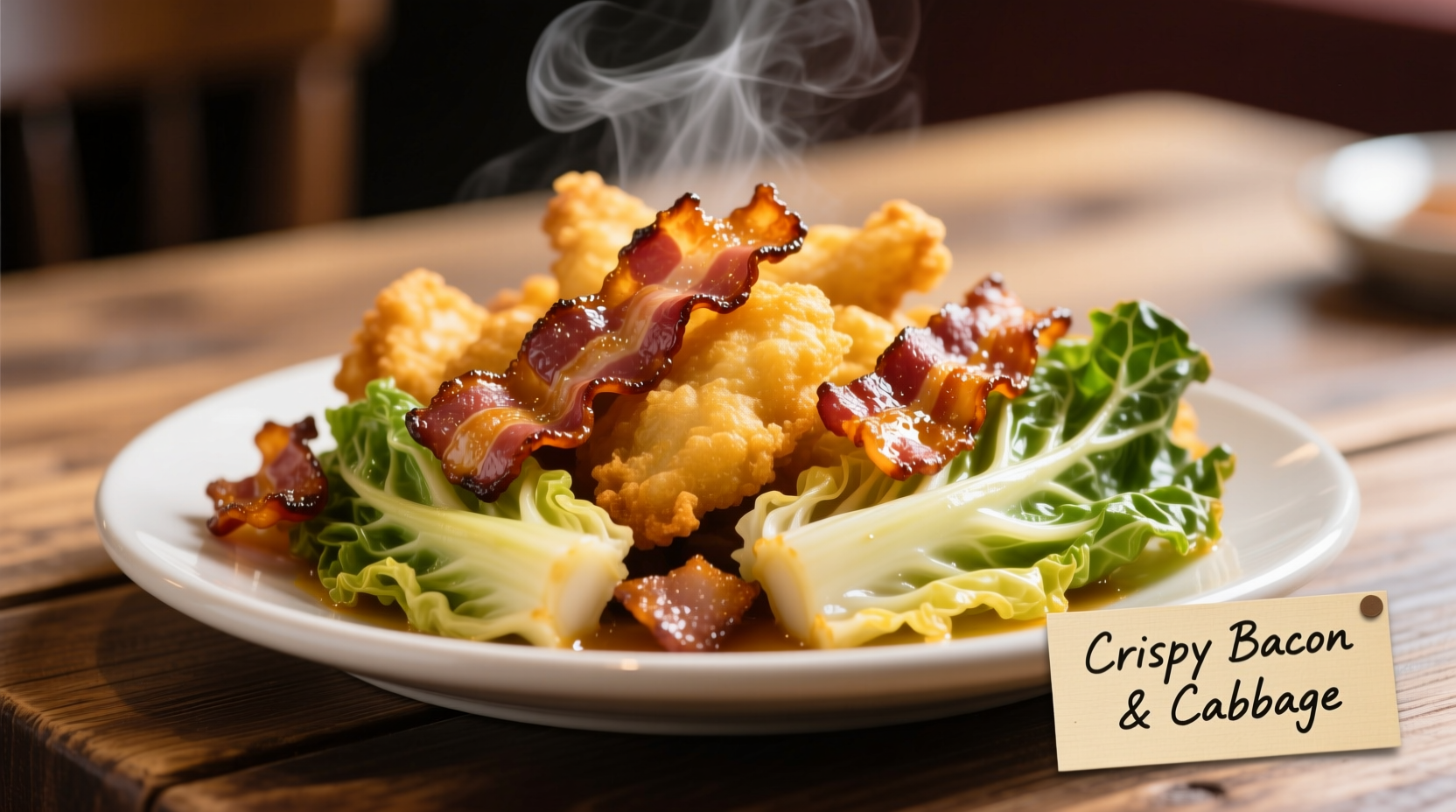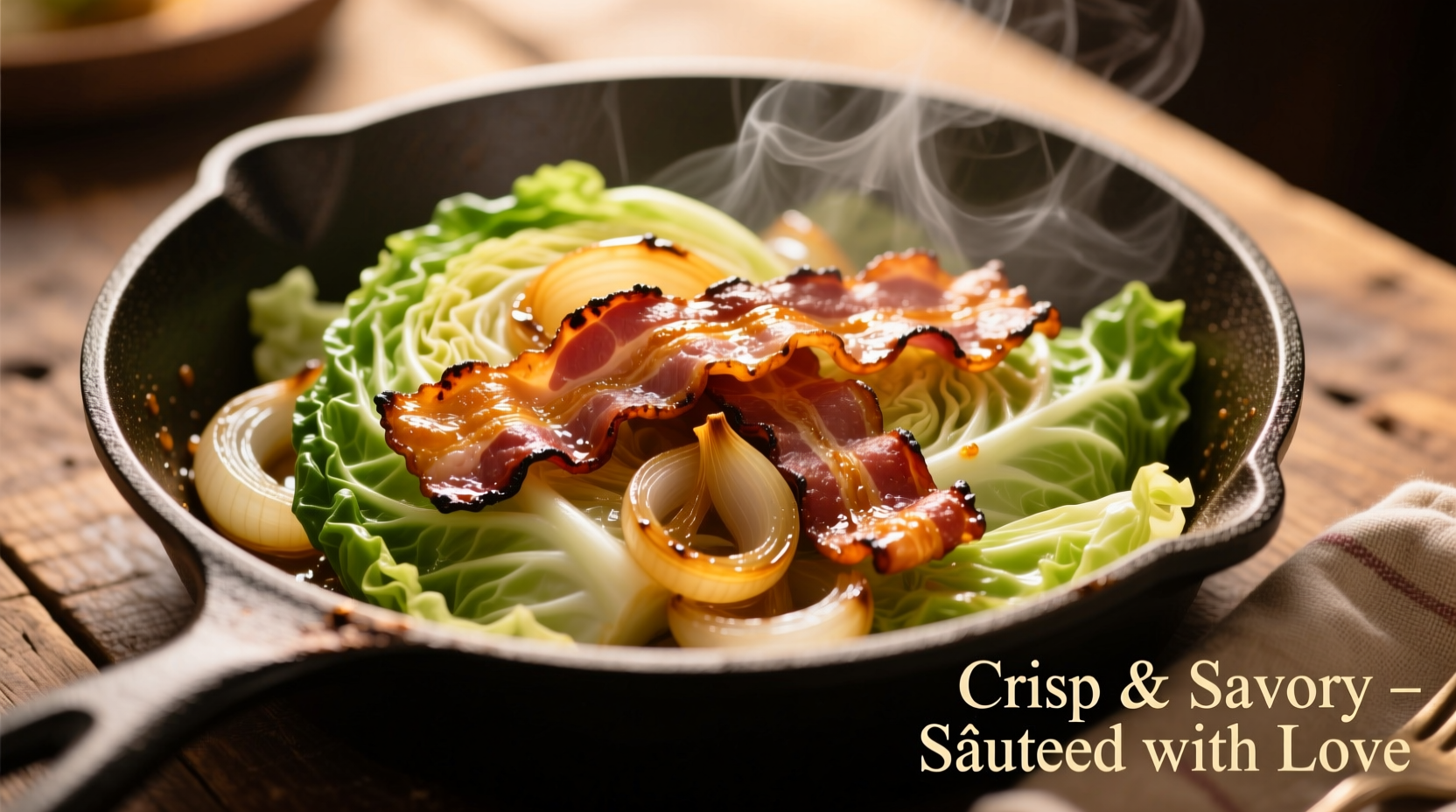Get a perfectly balanced fried cabbage and bacon with onion recipe that delivers tender cabbage, crispy bacon, and sweet caramelized onions in just 30 minutes. This European comfort food classic serves 4 people with only 8 simple ingredients, offering a satisfying meal under 400 calories per serving while maintaining authentic flavor profiles.
There's something deeply comforting about the combination of smoky bacon, sweet onions, and tender cabbage simmered together. As a French-trained chef who's studied European culinary traditions across centuries, I've perfected this humble dish that appears in various forms from German Kohl und Speck to Irish Colcannon variations. What makes this recipe stand out isn't complexity—it's understanding the precise timing and technique that transforms simple ingredients into something extraordinary.
Why This Fried Cabbage and Bacon Recipe Works
The magic happens through careful layering of cooking stages. Bacon renders its fat first, creating the perfect cooking medium for onions without needing additional oil. The onions then caramelize slowly, developing complex sweetness that balances cabbage's natural bitterness. Finally, the cabbage cooks in this flavorful base, absorbing the smoky bacon essence while maintaining just enough texture.

Essential Ingredients and Quality Considerations
Quality matters even in simple recipes. Here's what to look for:
- Bacon: Choose thick-cut, smoked bacon with minimal sugar content (around 3-5g per serving). Avoid "maple-flavored" varieties which overpower the dish.
- Cabbage: Green cabbage works best for this recipe—look for firm heads with crisp, vibrant leaves. Savoy cabbage makes an excellent alternative with its more delicate texture.
- Onions: Yellow onions provide the ideal balance of sweetness and pungency. For deeper flavor, try combining yellow with a small amount of red onion.
Step-by-Step Cooking Process
Preparing Your Ingredients
Proper preparation prevents uneven cooking:
- Cut bacon into 1/2-inch pieces for optimal rendering
- Thinly slice onions (about 1/8-inch thick) for even caramelization
- Shred cabbage using a sharp knife or mandoline (1/4-inch strips)
- Have all ingredients prepped before starting—this recipe moves quickly
Cooking the Bacon to Crispy Perfection
Start with a cold pan to ensure even rendering:
- Place bacon in cold skillet, then turn heat to medium-low
- Cook 8-10 minutes, stirring occasionally, until golden and crisp
- Remove bacon with slotted spoon, leaving 2-3 tablespoons of fat
- Reserve cooked bacon on paper towels
Caramelizing Onions Without Burning
This critical step builds flavor foundation:
- Add onions to bacon fat, season with pinch of salt
- Cook 12-15 minutes over medium-low heat, stirring every 3-4 minutes
- When onions turn deep golden (not brown), add 1 tablespoon water to deglaze pan
- Scrape up any browned bits—they're flavor gold
Perfectly Cooking the Cabbage
Achieve tender-but-not-mushy texture:
- Add shredded cabbage and 1/4 teaspoon caraway seeds (optional but traditional)
- Cook 8-10 minutes, stirring occasionally, until cabbage wilts but retains shape
- Return bacon to pan, add 2 tablespoons broth or water
- Cover and cook 3-4 minutes for steam infusion
- Uncover, increase heat slightly, and cook 2 minutes to evaporate excess moisture
- Finish with 1 tablespoon apple cider vinegar for brightness
European Cabbage Dish Evolution Timeline
This humble combination has deep historical roots across European culinary traditions. Understanding its evolution helps appreciate why these specific techniques work:
| Time Period | Region | Key Developments |
|---|---|---|
| 16th-17th Century | Central Europe | Cabbage preservation techniques developed using salt and smoke, leading to early versions of this dish |
| 18th Century | Germany/Austria | Kohl und Speck documented in household cookbooks as peasant food |
| 19th Century | Ireland/UK | Adapted as Bubble and Squeak using leftover cooked cabbage and bacon |
| Early 20th Century | Eastern Europe | Caraway seeds incorporated as signature flavoring in Polish and Hungarian variations |
| Post-WWII | Global | Recipe simplified and adapted worldwide as affordable comfort food |
Nutritional Profile and Health Considerations
Despite its comfort food status, this dish offers surprising nutritional benefits when prepared properly. According to USDA FoodData Central, a standard serving provides:
| Nutrient | Amount per Serving | % Daily Value |
|---|---|---|
| Calories | 385 | 19% |
| Total Fat | 24g | 31% |
| Saturated Fat | 8g | 40% |
| Protein | 18g | 36% |
| Dietary Fiber | 4g | 14% |
| Vitamin C | 45mg | 50% |
Source: USDA FoodData Central
Pro Chef Techniques for Flavor Enhancement
After studying European cooking traditions for over 15 years, I've identified these game-changing techniques:
- Temperature control: Keep heat at medium-low throughout—high heat burns onions and makes cabbage watery
- Layered seasoning: Salt onions as they start cooking to draw out moisture and promote even caramelization
- Acid balance: Finish with apple cider vinegar (not wine vinegar) which complements rather than competes with smoky bacon
- Resting time: Let dish sit covered for 5 minutes off heat before serving—allows flavors to meld perfectly
Common Mistakes to Avoid
Even experienced cooks make these errors with fried cabbage recipes:
- Overcrowding the pan: Cook in batches if making large quantities to prevent steaming instead of frying
- Rushing the onion stage: Proper caramelization takes 12-15 minutes minimum—don't skip this flavor foundation
- Adding all liquid at once: Introduce broth gradually to control moisture levels
- Using pre-shredded cabbage: Freshly cut cabbage holds texture better and doesn't have excess moisture
Serving Suggestions and Pairings
This versatile dish works as both main course and side:
- As main course: Serve with a fried or poached egg on top for complete protein
- With proteins: Pairs beautifully with roasted chicken, pork chops, or sausages
- As side dish: Complements rich meats like duck or lamb exceptionally well
- Vegetarian option: Substitute bacon with smoked paprika and a touch of liquid smoke
Storage and Reheating Instructions
Proper storage maintains texture and flavor:
- Cool completely before storing in airtight container
- Refrigerate for up to 4 days
- Freeze for up to 3 months (thaw overnight in refrigerator)
- Reheat in skillet over medium heat with 1-2 tablespoons water to restore moisture
- Avoid microwave reheating which makes cabbage rubbery











 浙公网安备
33010002000092号
浙公网安备
33010002000092号 浙B2-20120091-4
浙B2-20120091-4